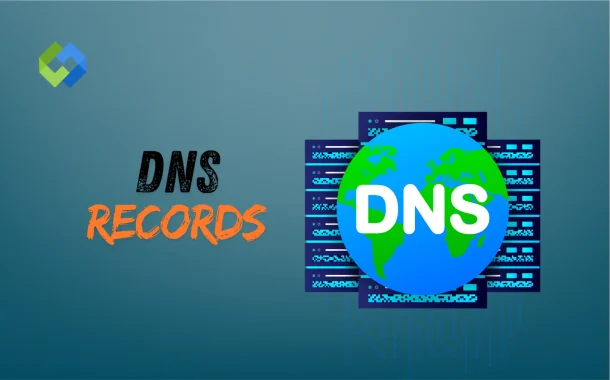To ensure seamless internet functionality and prevent potential issues, a comprehensive DNS record lookup is crucial.
In this thorough blog, we will examine the most important DNS records to be aware of, as well as the crucial question, “What DNS records should I look up?”
Table of Contents
Table of Contents
What are DNS Records
DNS Records, housed on authorized DNS servers, are vital instructions in the complex network of the global web. These details provide crucial information about a domain, including the Internet Protocol (IP) address associated with it and directing the processing of incoming queries.
DNS records serve as the foundation for data, facilitating the conversion of machine-readable IP addresses into human-readable domain names.
These records follow a particular pattern known as DNS syntax, which is made up of several text files that provide the vital information required for the website to operate correctly. Every record type has a specific function in coordinating the movement of information and resources throughout the digital environment.
Fundamentally, DNS records provide the essential framework that enables safe and effective internet interactions, making our globally networked world possible.
Top DNS Records
IPv4 Address Record (A Record)
The A record, which is the foundation of DNS, associates a domain with its matching IPv4 address. It is a vital resource that sends web visitors in the right direction.
IPv6 Address Record (AAAA Record)
With the global shift to IPv6, the AAAA record becomes essential. It ensures compliance with the latest Internet Protocol by associating a domain with its IPv6 address.
Canonical Name Record (CNAME Record)
The CNAME record is utilized to create aliases, which forward domains to another domain. It is helpful in maintaining a single point of accessibility while administering several functions across various domains.
Mail Exchange Record (MX Record)
Mail servers that receive emails on behalf of a domain are designated by the MX record in order to provide email service. Accurate MX record configuration is essential for effective email exchange.
Text Record (TXT Record)
To enhance email safety, TXT records, which contain human-readable information, are often used for Sender Policy Framework (SPF) authentication, domain verification, and DomainKeys Identified Mail (DKIM) records.
Pointer Record (PTR Record)
PTR records, which link an Internet Protocol (IP) address to its corresponding domain and are primarily used in reverse DNS lookups, provide a means of verifying the authenticity of the server.
Name Server Record (NS Record)
NS records identify a domain’s authorized name servers. They are essential to the smooth operation of the DNS structure because they route DNS requests to the appropriate place.
Start of Authority Record (SOA Record)
Important details regarding the domain are contained in the SOA record, such as the domain serial number, email address of the domain administrator, primary authoritative name server, and timers for retrying and refreshing.
Which Records Need to Be Looked Up
To fully comprehend a domain’s architecture, take into account the following records while doing a DNS Record Lookup:
The DNSKEY Record
The DNS Safety Enhancements, or DNSSEC, are essential for protecting DNS data. This public key is stored in the DNSKEY record and is utilized to confirm the legitimacy of signed DNS data.
TLS Authentication Record (TLSA Record)
The TLSA records link a domain to a virtual certificate, improving web interaction safety in an age when internet safety is crucial.
Service Record (SRV Record)
Technologies like SIP and XMPP are identified via their SRV entries inside a domain. They are essential to maintaining efficient interaction between online applications.
Naming Authority Pointer (NAPTR Record)
NAPTR records are often utilized in the context of ENUM (Telephone Number Mapping) and SIP (Session Initiation Protocol). This assists in connecting phone numbers to SIP addresses, enabling VoIP communications.
Exploring the DNS Record Lookup Landscape
A lookup is made easier by a number of web resources. The resources, such as dig, nslookup, and internet-based services, provide information on a domain’s DNS record lookup. Through record-specific queries, you may reveal the complex network of a domain’s architecture.
Use the nslookup command on your terminal or command prompt to get started. For instance, type the following to get a domain’s A record:
“nslookup example.com”
Using this query, you may get the IPv4 address linked to the given domain. Likewise, by adding the record type to the command, you may retrieve additional records, like this:
“nslookup -type=mx example.com”
Using this query, the domain’s MX records are retrieved, revealing the mail servers in charge of processing electronic mail.
A Comprehensive DNS Record Lookup’s Significance
A thorough DNS Record Lookup is necessary for a number of factors:
Solving the problem
When dealing with connection or email transmission difficulties, a complete DNS records lookup can assist in detecting incorrect setups or faults in a domain’s DNS settings.
Domain Protection
For the security of the domain, you must comprehend DNS Records. requires confirming the DNSSEC feature signs and keeping a close eye out for unauthorized modifications.
Increasing the Effectiveness of Internet Services
DNS Records analysis turns into a tactical resource for enhancing the functionality of the website. This entails not just picking suitable hosts, as well as making sure that the cache is set up effectively to reduce latencies and improve customer service in general.
Organizations’ Smooth Transfers
Domains or resource transitions are common for organizations. A thorough DNS Records Lookup proves that it’s an essential resource for organizing and carrying out conversions with ease, hence avoiding operational interruptions.
In the End
All things considered, a thorough grasp of DNS Records is essential for anybody in a role overseeing internet access or resolving connection problems. The fundamental component of the DNS system is made up of the most important DNS Records, which include A, AAAA, CNAME, MX, TXT, PTR, NS, and SOA entries. Furthermore, while evaluating “What DNS records should I look up?” DNSKEY, TLSA, SRV, and NAPTR records give a comprehensive perspective of a domain’s credentials.
By doing a DNS Record Lookup, companies may strengthen the integrity, dependability, and efficiency of websites proactively rather than only as a reactionary solution to problems. Understanding the complex DNS environment is a rewarding task with the proper resources and expertise, ensuring the smooth operation of the internet world.














